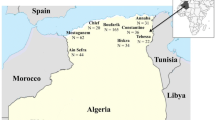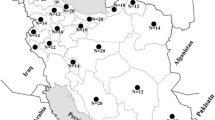Abstract
The genetic structure of the Iberian honey bee (Apis mellifera iberiensis) was studied by analysing 10 microsatellite loci in 362 workers representative of nine Spanish provinces. Heterozygosity values of Iberian honeybee populations are intermediate between African and west European ones whereas allelic diversity is remarkably high at several loci. There is no definite geographic structure of Iberian honeybee populations. At a peninsular scale, the expected clinal pattern observed with mitochondrial data has been probably lost due to the extensive practice of mobile beekeeping and increased colony trade-off. Due to these practices, it is expected that the genetic homogenisation will increase during the next years. Though this might have positive effects on honey production, putative ecotypes existing in Iberia would be prone to disappear.



Similar content being viewed by others
References
Arias, M.C., Sheppard, W.S. (1996) Molecular phylogenetics of honeybee subspecies (Apis mellifera L.) inferred from mitochondrial DNA sequences. Mol. Phylogenet. Evol. 5, 557–566
Arias, M.C., Rinderer, T.E., Sheppard, W.S. (2006) Further characterization of honey bees from the Iberian Peninsula by allozyme, morphometric and mtDNA haplotype analyses. J. Apic. Res. 45, 188–196
Belkhir, K., Borsa, P., Chikhi, L., Raufaste, N., Bonhomme, F. (2004) GENETIX, version: 4.05.2: logiciel sous WindowsTM pour la génétique des populations. Laboratoire Génome, Populations, Interactions. Université de Monftpellier II. Available from: http://www.genetix.univ-montp2.fr/genetix/genetix.htm
Cánovas, F., De la Rúa, P., Serrano, J., Galián, J. (2008) Geographic patterns of mitochondrial DNA variation in Apis mellifera iberiensis (Hymenoptera: Apidae). J. Zool. Syst. Evol. Res. 46, 24–30
Cavalli-Sforza, L.L., Edwards, A.W.F. (1967) Phylogenetic analysis: models and estimation procedures. Evolution 32, 550–570
Chapuis, M.P., Estoup, A. (2007) Microsatellite null alleles and estimation of population differentiation. Mol. Biol. Evol. 24, 621–631
De la Rúa, P., Galián, J., Serrano, J., Moritz, R.F.A. (2001) Molecular characterization and population structure of the honeybees from the Balearic Islands (Spain). Apidologie 32, 417–427
De la Rúa, P., Serrano, J., Galián, J. (2002a) Biodiversity of Apis mellifera populations from Tenerife (Canary Islands) and hybridisation with East European races. Biod. Cons. 11, 59–67
De la Rúa, P., Serrano, J., Galián, J. (2002b) Biodiversity of Apis mellifera populations from Tenerife (Canary Islands) and hybridisation with East European races. Biod. Cons. 11, 59–67
De la Rúa, P., Galián, J., Serrano J., Moritz R.F.A. (2002b) Microsatellite analysis of non-migratory colonies of Apis mellifera iberica from south-eastern Spain. J. Zool. Syst. Evol. Res. 40, 164–168
De la Rúa, P., Galián, J., Serrano, J., Moritz, R.F.A. (2003) Genetic structure of Balearic honeybee populations based on microsatellite polymorphism, Genet. Sel. Evol. 35, 1–12
De la Rúa, P., Jiménez, Y., Galián, J., Serrano, J. (2004a) Evaluation of the biodiversity of honey bee (Apis mellifera) populations from eastern Spain. J. Apic. Res. 43, 162–166
De la Rúa, P., Hernández-García, R., Pedersen, B.V., Galián, J., Serrano, J. (2004b) Molecular diversity of honeybee Apis mellifera iberica L (Hymenoptera: Apidae) from western Andalusia. Arch. Zootec. 53, 195–203
R Development Core Team (2008) R: A language and environment for statistical computing v2.8.1. Available from: http://www.r-project.org.
GRASS Development Team (2008) Geographic resources analysis support system (GRASS) v6.3.0. Available from: http://grass.osgeo.org
Epperson, B., Li, T. (1996) Measurement of genetic structure within populations using Moran's spatial autocorrelation statistics. Proc. Natl. Acad. Sci. USA 93, 10528–10532
Estoup, A., Garnery, L., Solignac, M., Cornuet, J.M. (1995) Microsatellite variation in honey bee (Apis mellifera L.) populations: hierarchical genetic structure and test of the infinite allele and stepwise mutation models. Genetics 140, 679–695
Franck, P., Garnery, L., Solignac, M., Cornuet, J.M. (1998) The origin of West European subspecies of honeybees (Apis mellifera): new insights from microsatellite and mitochondrial data. Evolution 52, 1119–1134
Franck, P., Garnery, L., Loiseau, A., Hepburn, H.R., Solignac, M., Cornuet, J.M. (2001) Genetic diversity of the honeybee in Africa: microsatellite and mitochondrial data. Heredity 86, 420–430
Garnery, L., Cornuet, J.M., Solignac, M. (1992) Evolutionary history of the honey bee Apis mellifera inferred from mitochondrial DNA analysis. Mol. Ecol. 1, 145–154
Garnery, L., Frank, P., Baudry, E., Vautrin, D., Cornuet, J.M., Solignac, M. (1998a) Genetic diversity of the west European honeybee (Apis mellifera mellifera and A. m. iberica). I. Mitochondrial DNA. Genet. Sel. Evol. 30, 31–47
Garnery, L., Frank, P., Baudry, E., Vautrin, D., Cornuet, J.M., Solignac, M. (1998b) Genetic diversity of the west European honeybee (Apis mellifera mellifera and A. m. iberica). II. Microsatellite loci. Genet. Sel. Evol. 30, 49–74
Gómez-Pajuelo, A. (1988) Situation of the varroatosis in Spain and Portugal. Present status of varroatosis in Europe and progress in the Varroa mite control, in: Cavalloro, R. (ed.) Proceedings of the Meeting of EC Experts’ Group Udine, Italy, pp. 41–43. ommission of the European Communities, Luxembourg
Gómez-Pajuelo, A. (2003) Introducción de reinas en las colmenas, Vida Apícola117
Hanotte, O., Bradle, D.G., Ochieng, J.W., Verjee., Y, Hill, E.W., Rege, E.O. (2002) African pastoralism: genetic imprints of origins and migrations. Science 296, 336–339
Kraus, F.B. (2005) Requirements for local population conservation and breeding. In: Lodesani, M., Costa, C. (eds.) Beekeeping and conserving biodiversity of honeybees. Sustainable bee breeding, theoretical and practical guide, pp. 87–107. Northern Bee Books, Hebden Bridge
Kumar, J., Nelson, R.J., Zeigler, R.S. (1999) Population structure and dynamics of Magnaporthe grisea in the Indian Himalayas. Genetics 152, 971–984
Manel, S., Schwartz, M.K., Luikart, G., Tarberlet, P. (2003) Landscape genetics: combining landscape ecology and population genetics. Trends Ecol. Evol. 18, 189–197
Manni, F., Guérard, E., Heyer, E. (2004) Geographic patterns of (genetic, morphologic, linguistic) variation: how barriers can be detected by “Monmonier’s algorithm”. Hum. Biol. 76, 173–190
Mantel, N. (1967) The detection of disease clustering and a generalised regression approach. Cancer Res. 27, 209–220
Mattila, H.R., Seeley, T.D. (2007) Genetic diversity in honey bee colonies enhances productivity and fitness. Science 317, 362–364
Miguel, I., Iriondo, M., Garnery, L., Sheppard, W.S., Estonba, A. (2007) Gene flow within the M evolutionary lineage of Apis mellifera: role of the Pyrenees, isolation by distance and post-glacial re-colonization routes in the western Europe. Apidologie 38, 141–155
Nei, M. (1978) Estimation of average heterozigosity and genetic distance from a small number of individuals. Genetics 89, 583–590
Pereira, T.C., Bittencourt, V.D.A., Secolin, R., de Souza-Rocha, C., de Godoy- Maia, C., Lopes-Cendes, I. (2007) Strand analysis, a free online program for the computational identification of the best RNA interference (RNAi) targets based on Gibbs free energy. Genet. Mol. Biol. 30, 1206–1208
Perrier, C., Strange, J., Langella, O., Sheppard, W.S., Garnery, L. (2003) Diversité génétique, introgressions mitochondriales et nucléaires dans une population d'abeilles des Landes de Gascogne. Actes du Bureau de Recherches Génétiques 4, 79–100
Pritchard, J., Stephens, M., Donnelly, P. (2000) Inference of population structure using multilocus genotype data. Genetics 155, 945–959
Raymond, M., Rousset, F. (1995a) An exact test for population differentiation. Evolution 49, 1280–1283
Raymond, M., Rousset, F. (1995b) GENEPOP version 1.2: a population genetics software for exact test and ecumenicism. J. Hered. 86, 248–249
Ruíz, M., Ruíz, J.P. (1986) Ecological history of trashumance in Spain. Biol. Conserv. 37, 73–86
Ruttner, F. (1988) Biogeography and taxonomy of honeybees. Springer-Verlag, Berlin
Slatkin, M. (1993) Isolation by distance in equilibrium and nonequilibrium populations. Evolution 47, 264–279
Smith, D.R., Palopoli, M.F., Taylor, B.R., Garnery, L., Cornuet, J.M., Solignac, M., Brown, W.M. (1991) Geographical overlap of two mitochondrial genomes in Spanish honeybees (Apis mellifera iberica). J. Hered. 82, 96–100
Smouse, P.E., Peakall, R. (1999) Spatial autocorrelation analysis of individual multiallele and multilocus genetic structure. Heredity 82, 561–573
Solignac, M., Vautrin, D., Loiseau, A., Mougel, F., Baudry, E., Estoup, A., Garnery, L., Haberl, M., Cornuet, J.M. (2003) Five hundred and fifty microsatellite markers for the study of the honeybee (Apis mellifera L.) genome. Mol. Ecol. Notes 3, 307–311
Streiff, R., Labbe, T., Bacilieri, R., Steinkellner, H., Glossl, J., Krener, A. (1998) Within-population genetic structure in Quercus robur L. and Quercus petraea (Matt.) Liebl. assessed with isozymes and microsatellites. Mol. Ecol. 7, 317–328
Walsh, P.S., Metzger, D.A., Higuchi, R. (1991) ChelexR 100 as a medium for simple extraction of DNA for PCR-based typing from forensic material. Biotechniques 10, 506–513
Whitfield, C.W., Behura, S.K., Berlocher, S.H., Clark, A.G., Johnston, J.S., Sheppard, W.S., Smith, D.R., Suarez, A.V., Weaver, D., Tsutsui, N.D. (2006) Thrice out of Africa: ancient and recent expansions of the honey bee, Apis mellifera. Science 314, 642–645
Wright, S. (1951) The genetical structure of populations. Ann. Eugen. 15, 323–354
Acknowledgements
Thanks are due to the many beekeepers and associations who generously collaborated with us in collecting the samples. Special thanks to O Rodríguez, J Ornia, E Muñiz, U Mediel and COAG association. Thanks to Dr. O Langella for his support with Populations software. We thank three anonymous referees for their valuable suggestions. This research has been supported by projects RZ00-013 (Instituto Nacional de Investigaciones Agrarias, INIA, Spain), EVK2 2000–00628 (European 5th Framework), BOS2003-9765 (Ministerio de Educación y Ciencia, Spain) and API06-010 COORD-2 (Ministerio de Agricultura, Pesca y Alimentación, Spain).
La variabilité des microsatellites révèle les effets de l’apiculture sur les populations d’abeilles espagnoles.
Apis mellifera / génétique des populations / cartes synthétiques
Zusammenfassung – Die Variabilität von Mikrosatelliten zeigt den Einfluss der Imkerei auf Populationen der Honigbiene in Spanien. Es ist bisher nicht klar, ob der bei den Bienen Iberiens beobachtete, den Breitengraden folgende Gradient der mitochondrialen DNA auch bei Mikrosatellitenmarkern auftritt. Erste Ergebnisse dazu zeigten eine höhere Variabilität von Mikrosatelliten in Afrika gegenüber Iberien und Frankreich, als Folge eines vermuteten genetischen Flaschenhalses während der letzten Eiszeit. Neuere Ergebnisse zeigten jedoch eine vergleichbar große Diversität in Populationen aus Belgien, Frankreich und Iberien. Es wurde vermutet, dass diese Ähnlichkeit durch die höheren Mutationsraten der Mikrosatelliten verursacht wurde, die die genetischen Effekte der Wiederbesiedlung nach der letzten Eiszeit verdeckt haben könnten.
Die zu testende Ausgangshypothese besagt, dass iberische Honigbienenpopulationen eine abnehmende Diversität von Süden nach Norden zeigen, wobei die Unterschiede zwischen Populationen hauptsächlich durch einen Isolation-by-Distance-Effekt zu erklären wären. Dazu wurden 10 Mikrosatellitenmarker in neun Populationen der Iberischen Halbinsel untersucht.
Der ausgeprägte Grad an genetischer Homogenität lässt vermuten, dass in jüngster Zeit ein beträchtlicher Genfluss zwischen den verschiedenen iberischen Populationen stattgefunden hat. Zwei verschiedene Prozesse können dafür verantwortlich sein. Der eine hängt damit zusammen, dass durch Varroa verlorenen gegangene Bienenvölkern wieder aufgebaut werden mussten. Dazu wurden verstärkt Ableger oder Schwärme gebildet, sowie Völker (oder begattete Königinnen), oft aus entfernten Gegenden, zusätzlich gekauft. Der andere Einfluss ist die Wanderimkerei, die im Durchschnitt 28.58% der spanischen Bienenstände betrifft (von 94.86% in Valencia bis 0.98% in Galizien, einschließlich La Coruña, Pontevedra und Orense).
Aus den Ergebnissen schließen wir, dass die Honigbienen von Iberien eine nahezu homogene Population bilden, jedoch mit einer Differenzierung zwischen einer östlichen, mediterranen Subpopulation (repräsentiert von Tarragona und Valencia), und einer westlichen, die die anderen Gebiete der Halbinsel einschließt.
Dieser unerwartete Grad an Homogenisierung wird wahrscheinlich durch Handel mit Völkern zwischen entfernten Gegenden und durch Wanderimkerei verursacht – das Ausmaß dieser Einflüsse muss jedoch noch bestimmt werden. Der Gesamteffekt dieser Prozesse liegt in einer Zunahme der genetischen Diversität innerhalb der Völker, zur Steigerung der Fitness und der Produktivität. Jedoch wird diese Homogenisierung zum Verlust möglicherweise vorhandener Ökotypen beitragen, das heißt, von Populationen, die an spezifische lokale Bedingungen nach vielen Generationen natürlicher und imkerlicher Selektion gut angepasst sind. In den nächsten Jahren wird es eine wichtige Aufgaben sein, Beiträge zur Erhaltung dieser Ökotypen zu leisten.
Apis mellifera / Populationsgenetik / Synthesekarten
Author information
Authors and Affiliations
Corresponding author
Additional information
Manuscript editor: Marina Meixner
Appendices
Appendix I
Appendix II
Rights and permissions
About this article
Cite this article
Cánovas, F., de la Rúa, P., Serrano, J. et al. Microsatellite variability reveals beekeeping influences on Iberian honeybee populations. Apidologie 42, 235–251 (2011). https://doi.org/10.1007/s13592-011-0020-1
Received:
Revised:
Accepted:
Published:
Issue Date:
DOI: https://doi.org/10.1007/s13592-011-0020-1




